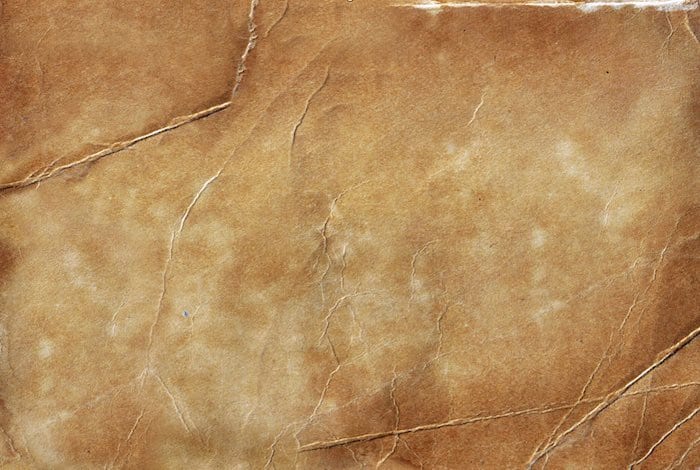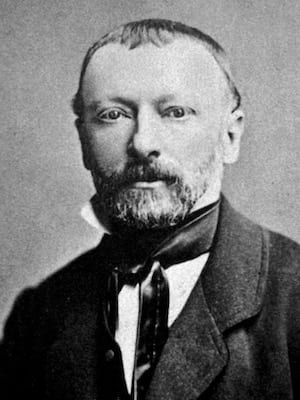Ludwig Traube
Ludwig Traube (1818 – 1876) was a German physician.
He was a pioneer of physiological experimentation in clinical medicine and pathology. Remembered for his introduction of clinical thermometry in 1850 and his descriptions of Traube space; Traube pulse (pulsus bigeminus); Traube sign; and Doppelton
Co-founder of Beiträge zur experimentellen Pathologie with Reinhardt and Virchow. Two issues were published in 1846 and 1847.
Biography
- Born 18 January, 1818 in Ratibor (Silesia), now Poland
- 1835 – Commenced medical studies at the universities of Breslau and Berlin
- 1840 – Graduated with M.D. degree from the University of Berlin; assistant to Johann Schönlein (1793-1864)
- 1841-43 – Moved to Vienna, Austria for further training in clinical medicine under Joseph Škoda (1805 – 1881) and Carl von Rokitansky (1804 – 1878)
- 1847 – Appointed privatdozent at the hospital Charité – Universitätsmedizin Berlin
- 1853 – Assistant professor at Charité – Universitätsmedizin Berlin (Berlin’s only public hospital, under the control of the Prussian army.)
- 1872 – Professor at Charité – Universitätsmedizin Berlin
- Died 11 April 1876, Berlin
Medical Eponyms
Traube sign and Traube ‘double-tone’ (1867)
Traube described two distinct sounds heard over the femoral artery in a 28 year old Prussian veteran of the Schleswig-Holstein military campaign, suffering from aortic insufficiency associated with rheumatic heart disease. Traube described the Doppelton (double tone) phenomenon when applying the stethoscope lightly over the femoral artery, so that the diameter of the vessel was not modified by compression.
Traube sign is the systolic (first) sound is caused by the rapid distension of the artery and likened to that of a pistol-shot. The Traube ‘double-tone’ is the second sound associated with the rapid change of tension of the arterial wall after the quick distension.
- Traube L. Über zwei eigenthümliche Phänomene bei Inusffizienz der Aortenklappen. Berliner klinische Wochenschrift, 1867; 4(44): 455-457. [Reported by Oscar Maximilian Victor Fraentzel (1838-1894), Traube’s pupil and his assistant from 1867 to 1869]
- Traube L. Ueber den Doppelton in der Cruralis bei Insuffizienz der Aortenklappen. Berliner klinische Wochenschrift, 1872; 9: 573
Traube’s space (1868)
Semilunar or crescent shaped anatomical space, overlying the gas bubble in the stomach and normally tympanitic to percussion.
- Anatomical margins: lower border of the left lung; anterior border of the spleen; left costal margin; and inferior margin of the left lobe of the liver.
- Surface landmarks: superiorly (left 6th rib); laterally (left mid axillary line); and inferiorly (left costal margin).
In the state of the vacuous stomach, and all the organs in the region being healthy, one can ascertain in the semi-lunar space a sharp tympanism with percussion, the absence of vocal vibrations by palpation and the absence of respiratory noise with auscultation.
Jacoud 1884
Percussion in Traube’s space is usually resonant, as it overlies the gastric bubble. Traube suggested that dullness to percussion over the space was a sign of pleural effusion; Parrino (1987) suggested that dullness to percussion may indicate splenomegaly. Dullness to percussion may also occur in postprandial patients. Sensitivity 0.62; Specificity 0.72 in detecting splenomegaly (Barkun 1989)
- Traube L. Bemerkungen über den halbmondförmigen Raum und über den Vocalfremitus. Berliner klinische Wochenschrift, 1868; 5: 509-511. [Reported by Oscar Maximilian Victor Fraentzel (1838-1894), Traube’s pupil and his assistant from 1867 to 1869]
Traube phenomenon (1871)
In the presence of peritonitis caused by perforation of the appendix, even though pain and sensitivity to pressure may not be present in the right iliac fossa, pain may be produced by palpation in the left iliac fossa. [See also: Perman-Rovsing Sign (1904, 1907)]
…weder die Schmerzen noch die krankhafte Empfindlichkeit gegen Druck sich in der Regio iliaca dextra am stärksten bemerklich machten. Es ist schwer, über die Ursache dieser Erscheinung Rechenschaft zu geben; denn wollten wir sie davon ableiten, dass der Entzündnngsheerd wegen seiner zu grossen Entfernung von der Bauchwand der Palpation in der Regio iliaca dextra nicht recht zugängig war, so durfte noch viel weniger ein Schmerz durch Druck auf die Regio iliaca sinistra hervorgerufen werden. Doch dem sei wie ihm wolle, jedenfalls sehen wir, dass eine von Durchbohrung des Wurmfortsatzes abhängige Peritonitis recht wohl vorhanden sein kann, ohne dass die Schmerzen und die krankhafte Empfindlichkeit gegen Druck ihren Hauptsitz in der Regio iliaca dextra zu haben brauchen.
…neither the pain nor abnormal sensitivity to pressure was present in the right iliac region. It is difficult to account for the cause of this phenomenon. It can be deduced that the inflammatory process was not quite accessible because it was at a greater distant from the abdominal wall and therefore could not be palpated in the right iliac fossa. Pain could be produced by palpatory pressure in the left iliac fossa. However, whatever the case may be, we can see that peritonitis caused by perforation of the appendix may be present, even though the pain and the morbid sensitivity to pressure may not present in the right iliac region.
Traube pulse (1872)
Traube coined the term ‘pulsus bigeminus’ in his classic paper presented to the Berlin Medical Society in 1871. Pulsus bigeminus is a variant form of pulsus alternans with alternate high and low character pulses, with the low pulses closer to the end of the previous high pulse than to the subsequent high pulse. Initially recorded on animals that had been curarized; then poisoned with potassium cyanide; and with both vagus nerves sectioned. In man, associated with severe left ventricular systolic impairment, and unfavourable outcomes.
The nature of the pulsus bigeminus may be said to be this: following every two pulses which originate in the aorta, a longer pause ensues. This phenomenon is differentiated from the pulsus dicroticus by the fact that in the latter there is only one contraction of the heart for every two beats of the pulse, while in pulsus bigeminus there are two contractions of the heart, which follow one another rapidly and are separated from the preceding and succeeding contractions by a longer pause.
Traube L. Ein fall von Pulsus bigeminus nebst Bemerkungen über die Leberschwellungen bei Klappenfehlern und über acute Leberatropie. Berliner klinische Wochenschrift, 1872; 9: 185-188, 221- 224
Key Medical Attributions
Clinical Thermometry
Investigated the pathology of fever. In 1850, Traube introduced measurement of temperature as a routine clinical examination method along with Friedrich Wilhelm Felix von Bärensprung (1822-1864), head of the department of syphilitic diseases at the Charité. In 1852 Traube produced the first graphic presentation of a fever course with simultaneous recording of pulse and respiratory frequency.
Controversies
Traube died aged 58 following repeated bouts of ‘angina pectoris’. He described/diagnosed his own perimortem condition as; “Hypertrophy and dilatation of both ventricles with arteriosclerosis and coronary sclerosis with partial fatty degeneration of the myocardia.“
Major Publications
- Traube L. Ueber periodische Thätigkeits-Aeusserungen des vasomotorischen und Hemmungs-Nervencentrums. Centralblatt für die medicinischen Wissenschaften, 1865; 3: 881-885. [Traube-Hering-Mayer waves]
- Traube L. Die Symptome der Krankheiten des Respirations und Circulations Apparats. 1867
- Mitteilungen aus der Klinik des Geiheimrats Traube: Über zwei eigenthümliche Phänomene bei Inusffizienz der Aortenklappen. Mitgeteilt von Stabsarzt Dr. Fraentzel. Berliner klinische Wochenschrift, 1867; 4(44): 455-457. [Traube sign]
- Mitteilungen aus der Klinik des Geiheimrats Traube: Bemerkungen über den halbmondförmigen Raum und über den Vocalfremitus. Mitgeteilt von Stabsarzt Dr. Fraentzel. Berliner klinische Wochenschrift, 1868; 5: 509-511. [Traube space]
- Traube L. Gesammelte Beitrage zur Pathologie und Physiologie. 1871 [Volume II]
- Traube L. XVI Ein Fall von Durchbohrung des Wurmfortsatzes Kothbrechen. In: Gesammelte Beitrage zur Pathologie und Physiologie I. 1871; I: 354-362 [Traube phenomenon]
- Traube L. Ein fall von Pulsus bigeminus nebst Bemerkungen über die Leberschwellungen bei Klappenfehlern und über acute Leberatropie. Berliner klinische Wochenschrift, 1872; 9: 185-188, 221- 224 [Traube pulse]
- Traube L. Ueber den Doppelton in der Cruralis bei Insuffizienz der Aortenklappen. Berliner klinische Wochenschrift, 1872; 9: 573 [Traube double tone]
References
- Jacoud S. Sémiologie de l’espace semi lunaire. In: Lecons de clinique medicale faites a I’hopital de la Pitie (1883-1884). 1885; 238-255
- Fresquet JL. Ludwig Traube (1818-1876). Historia de la Medicina.
- Morrison H. Ludwig Traube. Boston Med Surg J. 1927;196(26):1097-1101.
- Singer I, Haneman FT. The Jewish Encyclopedia: a descriptive record of the history, religion, literature, and customs of the Jewish people from the earliest times to the present day [Ludwig Traube]. Funk & Wagnalls, New York. 1906;12:235.
- Willius FA. Ludwig Traube and Pulsus bigeminus. Classics Of Cardiology 1941: 587-199
- Luisada AA. On the pathogenesis of the signs of Traube and Duroziez in aortic insufficiency. Am Heart J. 1943; 26(6): 721–736.
- Gershon-Cohen J. A short history of medical thermometry. Ann N Y Acad Sci. 1964; 121: 4-11.
- Parrino TA. The art and science of percussion. Hosp Pract. 1987; 99: 25–36
- Barkun AN et al. Splenic enlargement and Traube’s space: how useful is percussion? Am J Med. 1989;87:562–566.
- Verghese A, Krish G, Karnad A. Ludwig Traube. The man and his space. Arch Intern Med. 1992;152(4):701-3. [PMID: 1558425]
- Mackowiak PA, Worden G. Carl Reinhold August Wunderlich and the evolution of clinical thermometry. Clin Infect Dis. 1994 Mar;18(3):458-67.
- Luft FC. Traube’s double tone. Invited comment on: “Reports from the clinic of Privy Councilor Traube: two peculiar phenomena regarding aortic insufficiency”. J Mol Med (Berl). 2002; 80(11): 687
- Conti AA. Nineteenth century “Traube’s pulse” and current “Cardiac alternans”: significant features in the history of cardiology. Clin Ter. 2012;163(2):e71-2.
- Zhang G. Eponyms in Aortic Regurgitation. LITFL 2019
- Rastogi V. Abdominal Physical Signs and Medical Eponyms: Part I. Percussion, 1871–1900. Clin Med Res. 2020 Mar;18(1):42-47.

eponym
the person behind the name
Doctor in Australia. Keen interest in internal medicine, medical education, and medical history.

